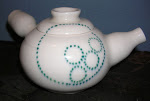On my website, I talk a little about Volvox aureus, and why I named the site after these colonial microorganisms, but this morning in the shower (where I do all my best thinking), I was giving it more thought. Decided I’d dissect the idea a little deeper.
As you may know, I studied Biology as an undergrad. Actually, I've studied biology my whole life – my parents both work in science/natural resources. Though my current career is not related to biology, the upbringing and education certainly shape my mind-set and artistic aesthetic. I like the idea that the name of my work connects my science background and my artistic expression.

Of course Volvox were named rollers for a reason. They're spheres within spheres. The parent (or grandparent) colony contains daughter (sometimes granddaughter) colonies. The spheres basically just float around, photosynthesizing and dividing until the daughters get too big for their britches, at which time the parent sphere breaks open to release the daughter colonies into the world. That's sort of how I feel about learning pottery. I started by taking classes, where I was part of a community of baby-potters, not ready to be on our own. After a while, I became a parent of sorts--still within the grand-parent pottery class, but starting to share my experience with others. This year, leaving PCC to join Radius has been a sort of release from the protective sphere of the classroom.
Pottery is a communal activity beyond the classroom. We all produce our own work, but we depend on other potters for a lot. Think this is something I'd like to explore in a separate post.


No comments:
Post a Comment